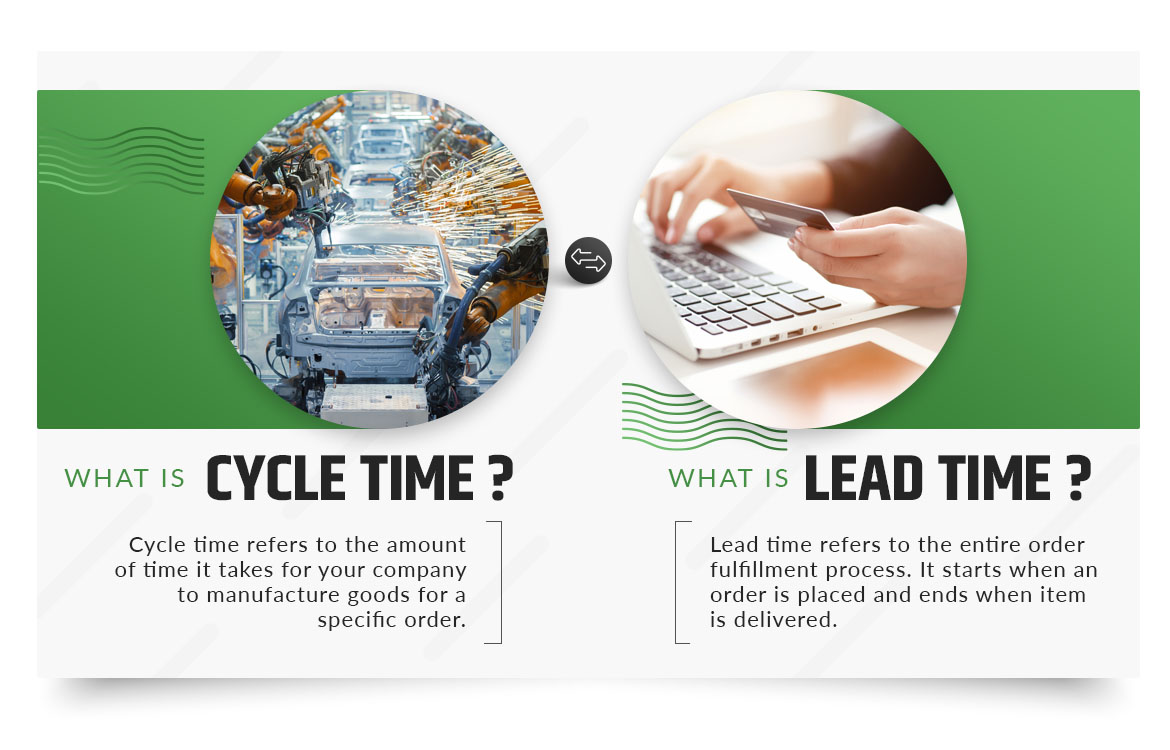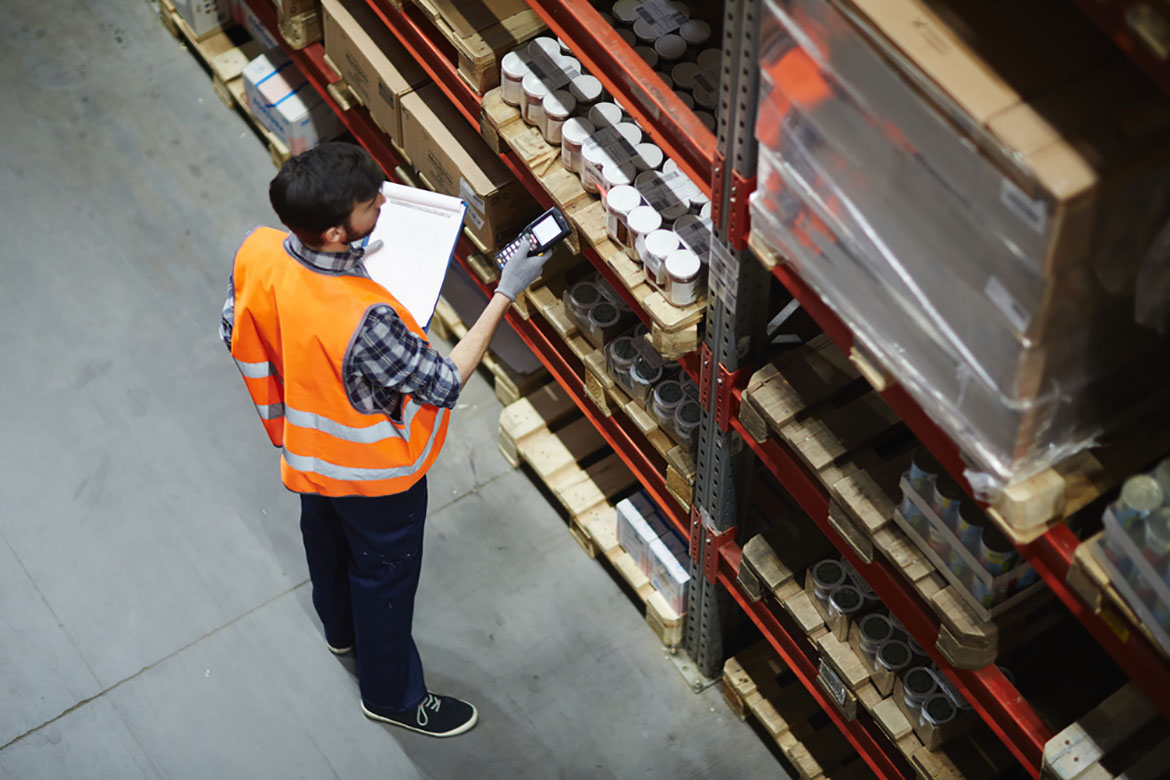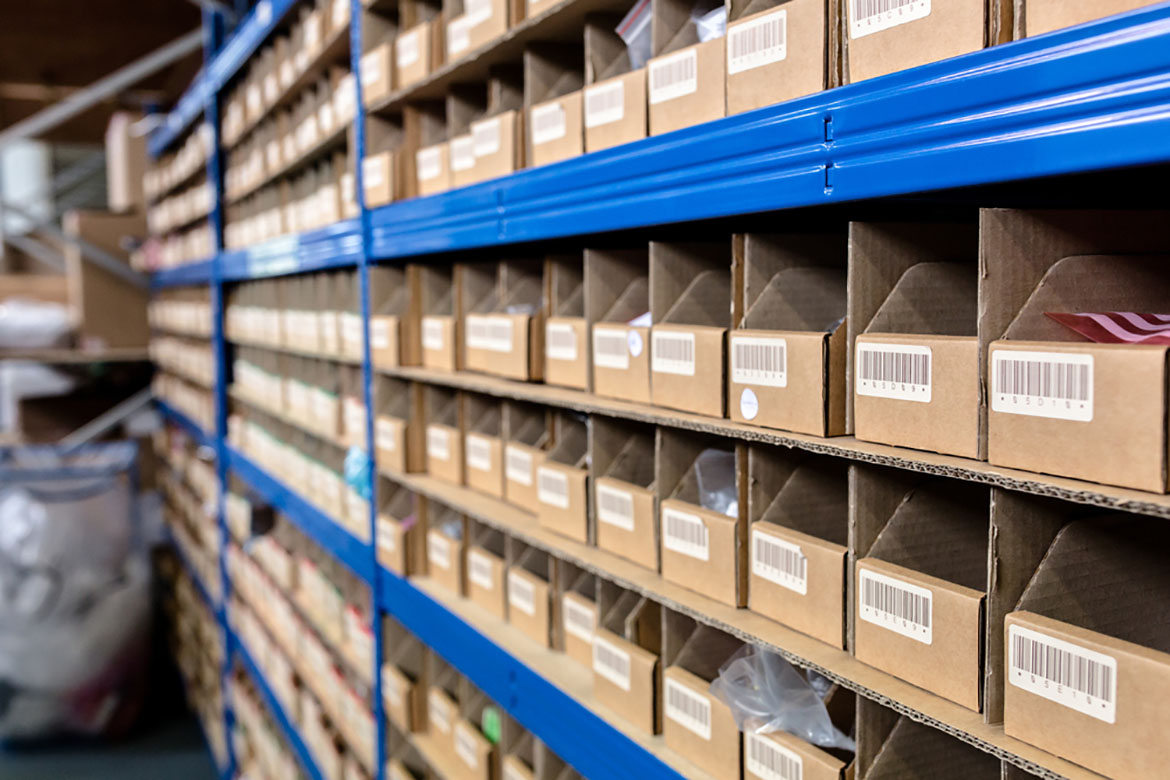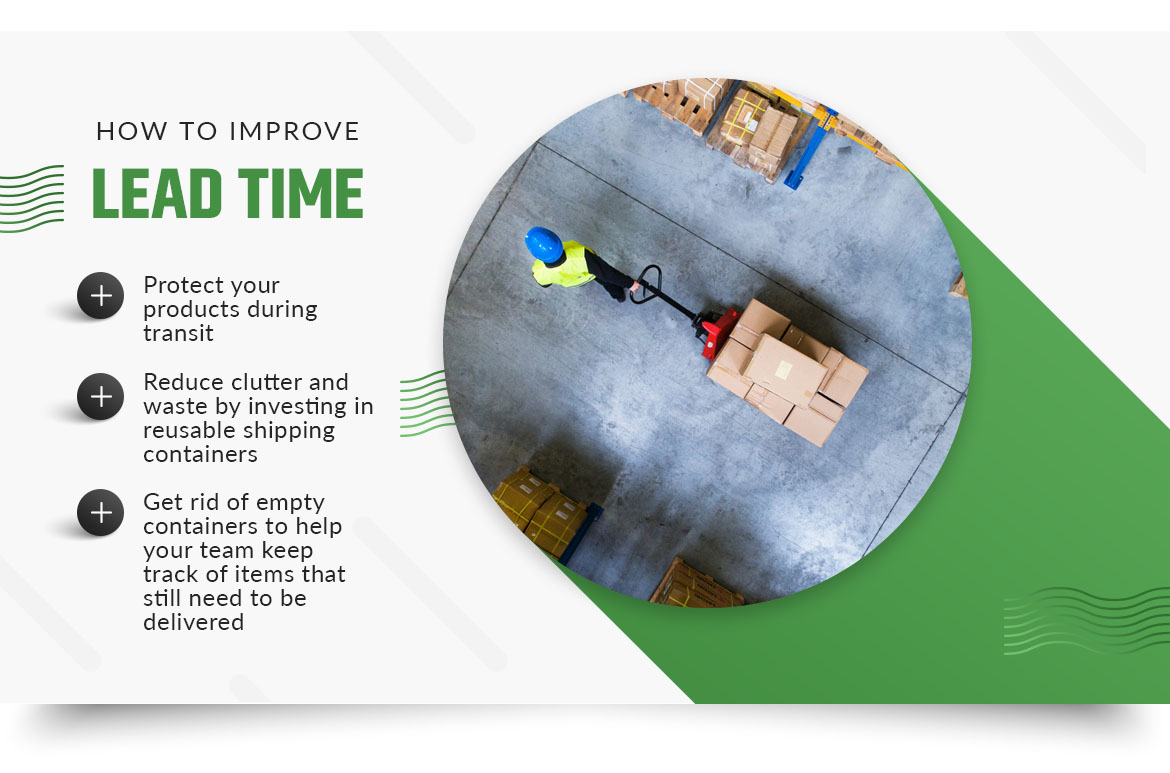
The manufacturing process can be complex and companies of all sizes need to make sure they are producing and delivering their products on time in order to succeed in today’s economy. Lead time and cycle time are two key performance indicators (KPIs) that businesses use to evaluate the production and shipping process. These terms often get used interchangeably but they refer to two different aspects of the supply chain. Understanding the differences between cycle time vs. lead time and the factors that affect them will help you meet your customers’ expectations.
The COVID-19 pandemic has upended cycle and lead times for manufacturers of all industries with products and shipping containers sitting idle at ports all over the world.
If you’re having trouble getting your products out the door or want to improve efficiency, learn how to calculate and improve these metrics to get your products out the door as quickly as possible.
What Is Cycle Time?
Cycle time refers to the amount of time it takes for your company to manufacture goods for a specific order. It starts when your company receives the order and ends when the item is ready for shipping. This includes the waiting period from when the item is complete to when it leaves the warehouse, as well as employee breaks.
Calculating Cycle Time
The simple way to calculate lead time is to measure the amount of time your workers spend manufacturing the product. If they are producing multiple products over a certain period of time, you can divide the number of products produced by the time it takes to produce them to find your average cycle time per product.
You also need to factor in the amount of time it takes for your employees to get to work once the order comes in. This could be a matter of seconds or several days if you need to wait on parts or supplies.
Cycle Time Example
Let’s say your company can produce 200 items over the span of 10 hours. Your average cycle time would then be 20 items per hour or one item every three minutes.
What Is Lead Time?
Lead time refers to the entire order fulfillment process. It starts from when the customer places the order and ends when the item is delivered to the customer. The cycle time is just one component of the total lead time.
Lead time includes order processing, the manufacturing process and post-processing, which includes shipping and delivery. Many companies will break down lead time into separate categories to focus on one aspect of their operations at a time.
- Order Lead Time: The amount of time it takes your company to fulfill the order. It starts when the customer places the order and ends when they receive it. Subtract the dates and times to calculate the exact order lead time.
- Order Handling Lead Time: The amount of time it takes your company to process the order. It starts when the customer places the order and ends when your company creates a sales order. Subtract the time to calculate the order handling lead time.
- Manufacturing Lead Time: The amount of time it takes your company to manufacture the item after receiving the sales order. It starts after the order has been processed and ends when the item is ready for shipping. Subtract the time and/or dates to calculate.
- Production Lead Time: The amount of time it takes your company to physically make the product. It starts when your employees start the manufacturing process and ends when the item is ready for shipping. Subtract the time and/or dates to calculate.
- Delivery Lead Time: The amount of time it takes your company to deliver the item after it has been made. It starts when the item is ready for shipping and ends when it has been delivered to the customer. Subtract the time and/or dates to calculate.
Calculating Lead Time
All you need to calculate lead time is the exact date and time of when the processes start and when they end. Subtract the two to come up with a statistical average. Your items may go through many different stages from when the order gets processed to the final delivery. It’s best to use an automated warehouse system to quickly collect this information every step of the way. Your workers should scan items every time they move from one phase to another. This will help you calculate specific numbers for each item or order.
If you don’t have an automated warehouse system or don’t scan your items, you can always use a simple stopwatch to measure the time. Consider running trials with your employees to see how long it takes them to complete tasks.
Lead Time Example
Let’s say a customer places their order at 5:30 p.m. on Friday afternoon. Your company receives the order, but your facility doesn’t operate on the weekends so you can’t start work until Monday morning. You then complete the product that afternoon. The next morning, you send the finished product out for shipping. It then takes five business days for it to reach the customer. It gets delivered the following Monday at 12:30 p.m.
Your total lead time would be nine days and 19 hours.
Factors That Affect Cycle and Lead Time
There are so many factors that can affect these two metrics. Let’s break down each stage of the process to see where things can go wrong.
- Order Processing
Your company should get a notification as soon as the customer places the order, whether it’s online or over the phone. The sales order may even be generated automatically. If the person is describing their order over the phone, it may take some time to fill in this information manually. Some customers may also make specific requests or custom orders. You will then have to enter the specifics into the system to make sure your workers have all the information they need to make the item. Once the order ticket has been created, it should then be relayed to the manufacturing facility as quickly as possible.
Communication can be an issue when processing orders and doling out instructions to warehouse employees. Everyone should understand the assignment clearly to make sure the item meets the customer’s expectations. If the order or item isn’t doable, your company should be quick to cancel the order.
- Manufacturing
So many delays can wreak havoc on the production process. Your workers should get started on the order right away to improve cycle time. They should have all the materials they need to manufacture the good from scratch or be able to locate it on the shelf.
Once the item has been made, it will need to be packaged and transported to the loading dock for shipping. It should have a label so it gets delivered to the right address.
- Shipping and Delivery
Whether you’re transporting the item yourself or working with a third-party logistics company, you should be able to track the progress in real-time. Keep the customer abreast of the situation if anything changes so they can adjust their expectations accordingly.
The containers should be easy to move so your workers don’t injure themselves in the process, without damaging the contents.
Are Your Lead and Cycle Times Good?
Cycle and lead times vary widely across industries. Studies show that when no inventory exists at the factory or with distributors, typical lead time to manufacture in the U.S. is between eight and 10 weeks after receipt of order.
Another way to measure the success of your operations is to calculate the takt time, which refers to the amount of time your company needs to manufacture and deliver the item based on the customer’s expectations once they place the order.
Let’s say someone places an order on your website on June 1 with an expected delivery date of June 25. Your company then has 25 days to fulfill the order to keep your promise.
If your orders are frequently delayed or your customers aren’t satisfied with your expected delivery date, it could affect your bottom line. Studies show just 15 percent of U.S. consumers are satisfied with current delivery rates.
How to Improve Cycle Time
Use these tips to make sure you and your team are manufacturing goods as quickly as possible:
- Labor Management
Keeping your workers on task is key to improving cycle time. They should always be in contact with a warehouse manager or automated system so they always know what to look for on the shelf. Use a voice direct warehouse management system to keep their hands free. They can listen to instructions without having to stare down at the screen, which can lead to accidents and poor posture on the job.
Help your employees work smarter, not harder. Use automation to find the fastest route to speed up the picking process. Assign workers to individual zones so they don’t have to walk from one end of the facility and back every time an order comes in. Keep popular items and commonly used tools and supplies near the manufacturing zone or loading dock to reduce downtime.
- Inventory Management
Help your workers find what they need by keeping your inventory organized. Store your supplies and products in bulk wire baskets to keep items visible on the shelf. Your team will instantly recognize the contents for faster retrieval times and less confusion in the workplace.
Shop New and Used Industrial Packaging and Warehouse Supplies
- Automation
Consider automating certain aspects of the manufacturing process. Sorting racks and conveyor belts can help you move inventory quickly without relying on physical labor. The warehouse management system should automatically print the label based on the customer’s information to make sure the item is going to the right destination.
How to Improve Lead Time
Keep these tips in mind to speed up the delivery and shipping process:
- Selecting the Right Shipping Container
Nothing could be more important than protecting your products during transit. You didn’t go through all that effort just to deliver a broken item. Keep goods and supplies in industrial metal storage containers for more peace of mind.
Reduce clutter and waste by investing in reusable shipping containers so your team doesn’t have to waste time recycling or disposing of trash at the end of the day. Choose containers close in size to your products to save on packing materials.
- Space Utilization
Getting rid of empty containers will help your team keep track of items that still need to be delivered. Use collapsible bulk containers to make more room in the truck or loading dock. They fit right onto a pallet so you don’t have to shrink wrap your goods to the pallet.
Shop New and Used Bulk Containers
Additional Considerations
If you continue to run into issues when fulfilling orders, you can always take fewer orders, hire more staff or consider scaling back your business so you don’t have to make as many products. If you can’t afford to automate some aspects of the supply chain or take on new staff, consider upping the price of your products.
Do your best to manage your customers’ expectations to make sure your lead time and takt time match up. Give them a clear estimate of when they should expect to receive the product based on your calculations. Continue to update these times as you adjust certain aspects of the manufacturing process.
Don’t forget to consider factors beyond your control when setting customer expectations. Bad weather, international relations, port congestion and staffing issues can affect your ability to get products out the door.
Keep this information in mind to keep your business operating at peak efficiency.
Image Credits
IIIerlok_xolms/Shutterstock.com
Bagel Studio/Shutterstock.com
feeling lucky/Shutterstock.com
Jenson/Shutterstock.com
NDAB Creativity/Shutterstock.com
Akarawut/Shutterstock.com
Halfpoint/Shutterstock.com
Simon Collins/Shutterstock.com
wavebreakmedia/Shutterstock.com
Pressmaster/Shutterstock.com






